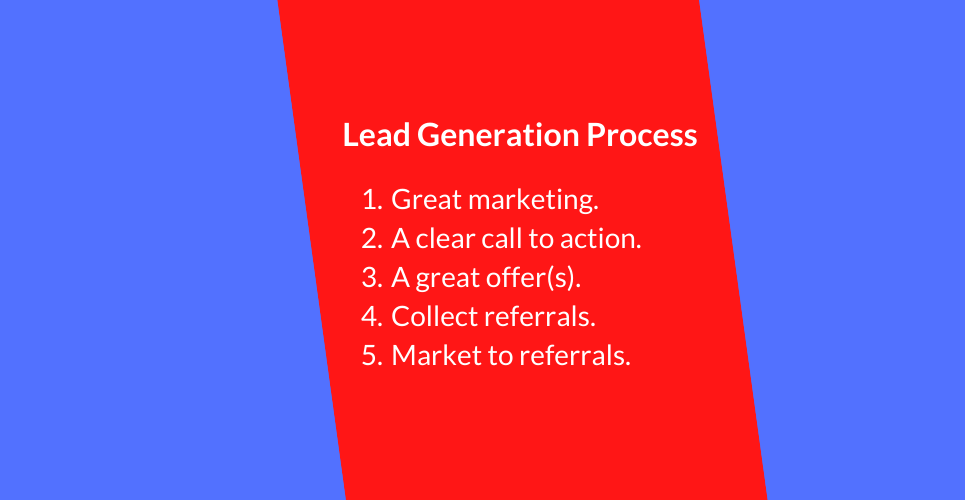Need some lead generation examples to kickstart your business?
Ever feel nervous about your inability to generate more sales leads for your business?
It’s been days, maybe even a week since you actually had a new customer.
What if you don’t get any customers this month? Do you even have enough money to last you for the next 30 days?
You’re scared, but you know you need to be confident. It’s hard.
You love being an entrepreneur, but customers seem to come and go, despite your best efforts.
If only there was a checklist of lead generation examples to kickstart a steady stream of new customers. That would make you more confident and help you avoid any uncomfortable conversations at home.
Have you ever felt this way? If you have, there’s good news, just keep reading. ;o)
You’ve survived launching your business, but the ebbs and flows of new customers can make owning a business stressful.
It doesn’t have to be this way.
You need a process in place that will generate sales leads for your business. With this, you’ll gain peace of mind and be able to sleep at night knowing you’ll have a consistent flow of new selling opportunities daily.
Before we dive into our list of lead generation examples, let’s start with what exactly a sales lead is.
What Is a Sales Lead? (and How to Qualify a Sales Lead)

When it comes to growing a business, there is nothing more important than sales leads. I learned this firsthand when I first launched my consulting business back in 2009.
I quit my job (a well-paying job, I might add) in May that year to launch my first business.
Although I had sold cars earlier in my career, I was unaware of just how much work went into generating sales leads. I presumed that people just came to the dealer’s lot because they wanted to buy a car.
Turns out they were shopping based on the various marketing activities the dealer was doing.
When I reflect back on first launching my business, plenty of my time in the early days of my business was spent sitting on the back deck. I was pondering how in the heck I was going to grow the business because the phone just wasn’t ringing off the hook.
The gap in my plan had been developing a systematic way to continuously attract sales leads, just like the dealer I had worked for earlier had done.
Using Marketing for Sales Leads
When it comes to generating sales leads, ideally a long line of pre-qualified buyers will beat down your door.
This might seem impossible (for those that have attempted it), but when you use effective marketing for sales leads, this can be accomplished.
The goal in any marketing is to attract sales leads that would make ideal customers. Defining your ideal customer then becomes the starting point for any marketing you do.
Put simply, you can’t attract your ideal customer if you don’t speak to him or her directly.
Once you know exactly who you want as an ideal customer (you’ve defined your niche), and you define exactly what it is that they want (the value you’ll provide), you’ve hit gold.
This won’t happen overnight.

It will take time to test your message and determine the best type of marketing for sales leads that will work for your business. But once you’ve got this buttoned-down, you’ll see a steady stream of leads for your business.
A great resource if you want to learn more about how to create effective marketing is a book written by Dan Kennedy called “Magnetic Marketing”.
Once you’ve honed your message, start to spread the word using some of the lead generation examples we list later in this post. Ideally, you use the channels that your ideal customers frequent, so as to place your message in front of them.
Social media is a popular option because it offers both free and paid options.
Direct mail is still effective for a specific demographic, as are print ads.
Wherever your ideal customers hang out, that’s where you’ll want to place your marketing.
Generating New Sales Leads
Having your ideal customers seek your business out is the ideal situation.
This doesn’t happen without significant time and effort, particularly when it comes to testing your message.
If you’d like to try something else while you wait for your marketing to attract drones of customers to your door, you might want to try one of the following ideas.
Have a Great Product?
If you have a great product (and we’ll assume you do!), then quite possibly giving away your product is the best way to generate leads. If you’re over the age of 30, you’ll likely remember Columbia House, who gave away CDs for a penny.
I’ve even been offering a free copy of my book, a product of my work, to attract sales leads. It really doesn’t matter what your product is, as long as it has value to your ideal customers.
By offering your product for test or trial, you can attract new sales leads. Is your product something you can give away as part of a test or trial period?
Is Your Service Exceptional?
If you have a great service, it’s possible you can use the service to generate sales leads. Sirius XM, which offers a free trial of their streaming music service to anyone who is not a current customer, has been doing this for years.

The key in offering your service to generate sales leads is in ensuring potential customers are clear on the terms of their trial. There is nothing more harmful to a company’s reputation than when they are perceived to be trapping their customers into long-term contracts by offering their service for free.
Make it clear upfront as to how long the trial of your service is, what it includes and doesn’t include, and exactly what potential customers need to do to end the service.
Software companies like ClickFunnels do a great job of being clear on addressing these exact points and making it easy for potential customers to opt-out of the service. They even go so far as to offer training to learn more about how to build a funnel that attracts sales leads.
If you’re interested in building a funnel, you can learn more here.
The Power of Referrals
If you have a great product or service, but giving it away doesn’t make sense, then why not get your current customers to help you generate sales leads?
Referrals (also known as referral marketing) have long been the most appealing way to attract customers because it requires very little effort and no cost.
If your customers are happy, why not ask them to tell others about their experience? Give them a reason to tell others by offering discounts on future purchases, bonuses, or even freebies.
Gyms like GoodLife fitness have been doing this for years. Their “refer a friend” program allows gym members who enjoy their experience to introduce friends to the gym, and in return, they can get a t-shirt or other gym attire.
It’s a win-win scenario, and when you consider the lifetime value of a gym membership, a t-shirt is a small price to pay.
What Is Lead Generation? (How Does It Work and Why Do You Need It?)
Until this point, we’ve spent time discussing the various ways to generate sales leads through creating awareness for your products or services. The awareness strategies we’ve discussed will begin attracting new potential customers to your business.
Once you’ve attracted customers, however, you’ll need a step to qualify the sales leads in order to move them into your sales process.
How to Qualify a Sales Lead

To qualify a sales lead is to ensure you are focusing your marketing efforts and time on people who are:
- Your ideal future customer
- Someone who is ready to buy (preferably now), and
- Someone who will become a long-term customer.
Typically, there are several questions you’ll want to address in order to qualify your lead. Addressing these questions in your marketing will ensure that you aren’t spending money or time trying to qualify the wrong people.
Qualification steps are usually built around answering the following questions:
- Are they your ideal customer?
- Do they have money or financing available to buy your product or service?
- Are they interested in buying what you have to offer? If not, can you convince them that your offering satisfies their needs?
- Are they ready to buy now? If not, when?
Lead generation is obviously a necessary part of converting the prospective customer to an actual customer. This said, there are steps you can take that will ensure the right prospects become your ideal customers. This is where a solid lead generation process comes into play.
What Does a Good Lead Generation Process Look Like?

In order to create some predictability in your flow of new customers, putting a process in place is a good idea. Essentially, by taking the steps you’ve found most effective in how you attract, qualify, convert, and retain customers, you can create a steady flow of new customers that will help you grow and scale the business.
This is your lead generation process.
There can be many steps in a lead generation process, depending on your product, service, market, and customer. A more complex or costly product, like software, for example, can have more steps in order to move from a prospect to a customer.
This said, every lead generation process has five key steps:
1. Great Marketing
As we discussed earlier in detail, you can use various marketing strategies, including using your product or service to attract your ideal customers.
The main tools for marketing today include content marketing, email marketing, paid advertising, blogs, social media, and product trials. I’ve written about how to use these tools to develop effective marketing here.
2. Clear Call to Action
Once you get the attention of your ideal customer through the use of these tools, there must be a reason for them to act. This is often referred to as a “call to action”. What should your ideal customer do once they read your content, your ad, or your post on social media? What is their next step?
3. A Great Offer

Quite often, an effective call to action is to provide your prospective customer with something they value. This might be something you provide for free or something they pay to get.
The key is to ensure it is something that helps to solve their problem or move them towards what it is you offer. A hairdresser, for example, might offer a free pedicure, which brings the employee to their salon, costs them very little, and provides the salon owner a chance to sell them other, higher-value services.
4. Collect Referrals
When it comes to finding new sales leads and getting new customers, there is no easier way than a referral.
More often than not, referrals you receive will come from your best customers. As a result, a referred customer is likely going to fit your criteria for an ideal customer. Since they were referred to you, the conversion from lead to customer is also going to be much easier and faster.
The challenge with referrals, though, is they often don’t happen naturally. It will take some work on your part to convince existing customers to refer others.
You’ve likely seen your dentist do this, and maybe your insurance broker or even realtor. Service-based businesses often rely on referrals heavily as an easy way to get their foot in the door.
Since customers can’t necessarily judge the quality or competitiveness of their products as easily, relationships and experience become the main qualifiers as to whether they get the business.
Either way, once you’ve got a new customer, make sure that you ask satisfied customers for referrals. You can even go so far as to ask those who chose not to work with you or buy your products.
5. How to Market to Your Customer Referrals
Considering that referrals are the easiest way to generate a sales lead, it makes sense to focus your efforts on getting as many referrals as possible.
In my own business, I developed the habit years ago of asking even those leads that decided not to work with me for a referral. I’d say something like,
“I understand now may not be the right time for us to work together, and that’s fine. I’m curious, though: is there someone you think I might be able to help?”
Once you have a method in place to ask for referrals, consider how you market to those referrals because it should be different.
With sales leads that are already introduced to your products and services by someone they know, the first hurdle is already addressed.
To market to referrals effectively, then, you’ll want to use methods that suggest a closer relationship, and that treat the referral with the same respect and support that you would an existing customer.

The goal is to act fast and make the referee’s access to your products or services as painless as possible.
A few pointers to incorporate with your referral marketing to increase your effectiveness:
1. When you receive the referral, act immediately. Presumably the referrer has told the referee to expect to hear from you.
2. Include the referrer in your initial communication to the referee so that they know you’ve followed up with the referral.
3. Always thank the person who referred the customer with a small gift or reward of some kind. Be creative! You want them to enjoy referring and feel appreciated so that they do it again and again.
If you get this step right, you’ll generate sales leads continuously that will take a lot less work to close than other leads.
16 Lead Generation Examples to Unveil New Sales Leads
Now that we have gone over the strategy behind generating leads and the steps to generating sales leads, let’s talk tactics.
What specific actions can you take, or can your team be taking, on a daily, weekly, and monthly basis to help you generate new sales leads?
Become a Social Media Maven!
1. Create a Social Media Presence
Create a social media profile for your business on any platforms that you believe your ideal leads will be spending time on. If you are in the B2B market, for example, LinkedIn is a great place to be.

If you are in the B2C market, create a Facebook business page.
2. Get Discovered on Social Media
Make sure that the profiles you create speak to your ideal leads. Mention the kind of work you do; include testimonials from satisfied customers; add frequent content to ensure you continue to show up on people’s feeds.
3. Use Social Media to Find Sales Leads:
On LinkedIn, for example, you can search by business, by title, and even by region. Using social media in this manner allows you to search for the people who could become leads.
Once you find them, reach out to connect. When they do connect, any content you add will start to show up in their news feed.
Give Your Leads a Reason to Connect
4. Put a Call to Action in All of Your Communications
Whether you are publishing content on social media or sending letters or postcards, there should always be a reason for the lead to contact you.
This is called a “call to action”, which is the next step you recommend a lead takes once they’ve consumed your content. Ensuring all of your communications include a call to action ensures that your leads can easily reach out to you when they want to.
5. Use Content to Attract Your Sales Leads
Being on any social media channel allows the opportunity to publish content that your prospective customers will find interesting. In doing so, you are indirectly marketing your services that allow you to attract sales leads.
Make sure there is a call to action in everything you publish, enticing the reader to connect with you. Then have them contact you!
6. Create a Referral Program
We’ve talked about the power of referrals earlier. If you want to generate leads, there is no better place than starting with your current customers.
Ask every customer for a referral, providing them an incentive to do so. The lead is generated for you, and it takes far less effort to convert a referral from a lead to a customer. Don’t miss this opportunity!
Use Cold Outreach to Generate New Sales Leads
7. Make It Easy for Leads to Contact You
Regardless of how many social media platforms you use, make sure that every piece of content you publish includes your contact information. If you have a website, put your phone number and email front and center.
If you send emails, make sure every email signature includes contact information.
8. Tap Into Your Networks
Make sure that everyone you know understands what you do and how you help customers. When I first launched my business nearly 15 years ago, I made a list of everyone I knew, from high school friends to former colleagues and every family member I had.

The list ended up being 238 people (I still remember it vividly), and I closed my first piece of business from the activity.
9. Tap Into Your Employees’ Networks
Make sure you have your employees go through the same exercise as number 8 above.
Ask them to let everyone know where they are working and how you help customers. Give them an incentive to reach out (i.e., a percent of any business generated), and provide them the time during their working hours to complete the activity.
The key here is not to force them into this activity, but simply to ask that they do so.
10. Networking (Yes, It Still Works!)
This is an obvious one, but still one of the best ways to make connections with possible sales leads.
Although I was never a fan of simply attending events to mingle with others, you can consider any activity in which you make connections with people who would otherwise be strangers as networking.
Participating in events, attending conferences, or even doing online training where you can interact with others all constitute networking. By simply telling people what you do (after you introduce yourself, of course), you expand your opportunities for new leads.
11. Run an Event in Person or Virtually
People who speak are typically seen as experts—the exception being if you are an extremely poor speaker.. 🙂
This said, if you have the confidence to speak in front of others and you have something valuable to say, why not run a workshop?
Teach a concept you’ve used successfully to help your ideal customers help themselves.
You’ll be seen as an expert and anyone who participates will now become a lead that you can market to.
Become a Funnel Master!
12. Use Your Website to Generate Leads
If you have a website, make sure you put it to work. Include statements about the results you’ve achieved for customers and the problems you’ve solved.
Better yet, add testimonials from happy customers, all with the intention of creating awareness to others about the work that you do and how it might help them. Include very clear opportunities for people to reach you via email, phone, or even live chat.
Check out an example on my homepage by clicking here.
13. Become Active Online
There are plenty of opportunities to engage with potential leads online beyond just publishing content and having a website.
Facebook groups, LinkedIn groups, platforms such as Quora, and even other people’s blogs all offer the opportunity to engage with possible leads.
Pick several platforms and scan weekly for questions related to what you do and how you help customers. Answer with the intention of helping others and ensure your contact information and website are included in your bio.
The Golden Rule of Generating Sales Leads!
14. Don’t Forget About Your Lost Leads
If you’ve put the effort into finding a new lead and propose the sale of your product or service to them, and they don’t move forward, don’t ever let go.
These leads are warm (they know you, your product, or service) and although the timing might not have been right for them to proceed, it doesn’t mean they won’t proceed at some point in the future. Make sure you stay in touch and remain helpful.
Lead Generation Examples Through Broadcasting
15. Get Involved in Podcasting
Another more recent trend is the growth in podcasts. You can choose to start your own, or you simply become a guest on other podcasts. Either way make sure you test this as it is a great way to generate traffic to your website and social media profiles.
By participating in podcasts, for example, you can tap into the network of the podcast host, and when you give them a reason to contact you, you are asking those who might be interested in your work to reach out.
16. The Power of YouTube
We can’t talk about social media without referencing YouTube. Now one of the most popular and powerful search tools next to Google, YouTube has millions of potential leads just waiting to engage with you.
Setting up a channel is easy and free, and by placing frequent content on the channel, you can pique the interest of leads.
A few musts to be successful on YouTube: Make sure you use good lighting and sound (poor quality is a turn-off for most). Also, ensure you have a strong bio and include all of your contact information.
Lastly, for people that do view, make sure you add content on a regular basis, to avoid stagnation.
You can check out my channel as an example here.
Getting the Most from Your Lead Generation Efforts!
As I mentioned earlier, lead generation can take both your time and money. That said, ensuring you track the results from your efforts is key to avoid wasting either.
Tools for Sales Lead Generation
Depending on which lead generation technique you’re using, there are various tools that can prove to be effective. If you are using social media, platforms like Facebook and LinkedIn allow you to view the number of people that are viewing your profile or clicking on links.
For those activities that are more face-to-face, you can track how many business cards you collect or how many emails you receive.
The key is, know what works. Then do more of it. Preferably before you invest much money or time.
I challenged you earlier to test as many of the 16 sales lead generation strategies as possible.
The reality is not every one of them will be effective.
By monitoring the number of leads you collect AND how easily you can convert the leads to customers, you’ll start to identify the best lead generation methods for you and your business.
Successfully Generating Repeated Sales Leads (Over and Over Again)
To drive continued interest and to entice leads to contact you, be sure to constantly create new offers of value to your prospective customers. From free samples, to service trials, to checklists, the number of free offers you can create is endless. Its variety will help ensure you connect with each individual prospect.
Use These Lead Generation Examples to Create Your Funnel of Sales Leads
As you can see, generating sales leads is a must if you want to continually build your business.
From the lead generation examples provided here, find what works, and do it over and over again.
When results slow, make sure to try new ideas.
What would the impact be on your business if you could continually generate leads?
My guess is you’d definitely get more sleep. More importantly, however, you’d create a predictable means to consistently attract your ideal customers.
Those are the ingredients for a business that is successful in the long term.
What strategy will you get started with?
© Shawn Casemore 2020. All Rights Reserved.


Share This Article
Choose Your Platform: Facebook Twitter Google Plus Linkedin